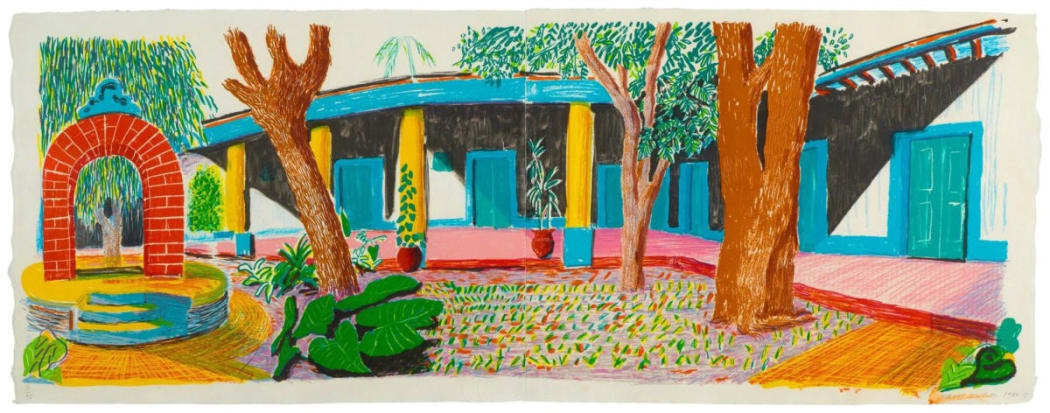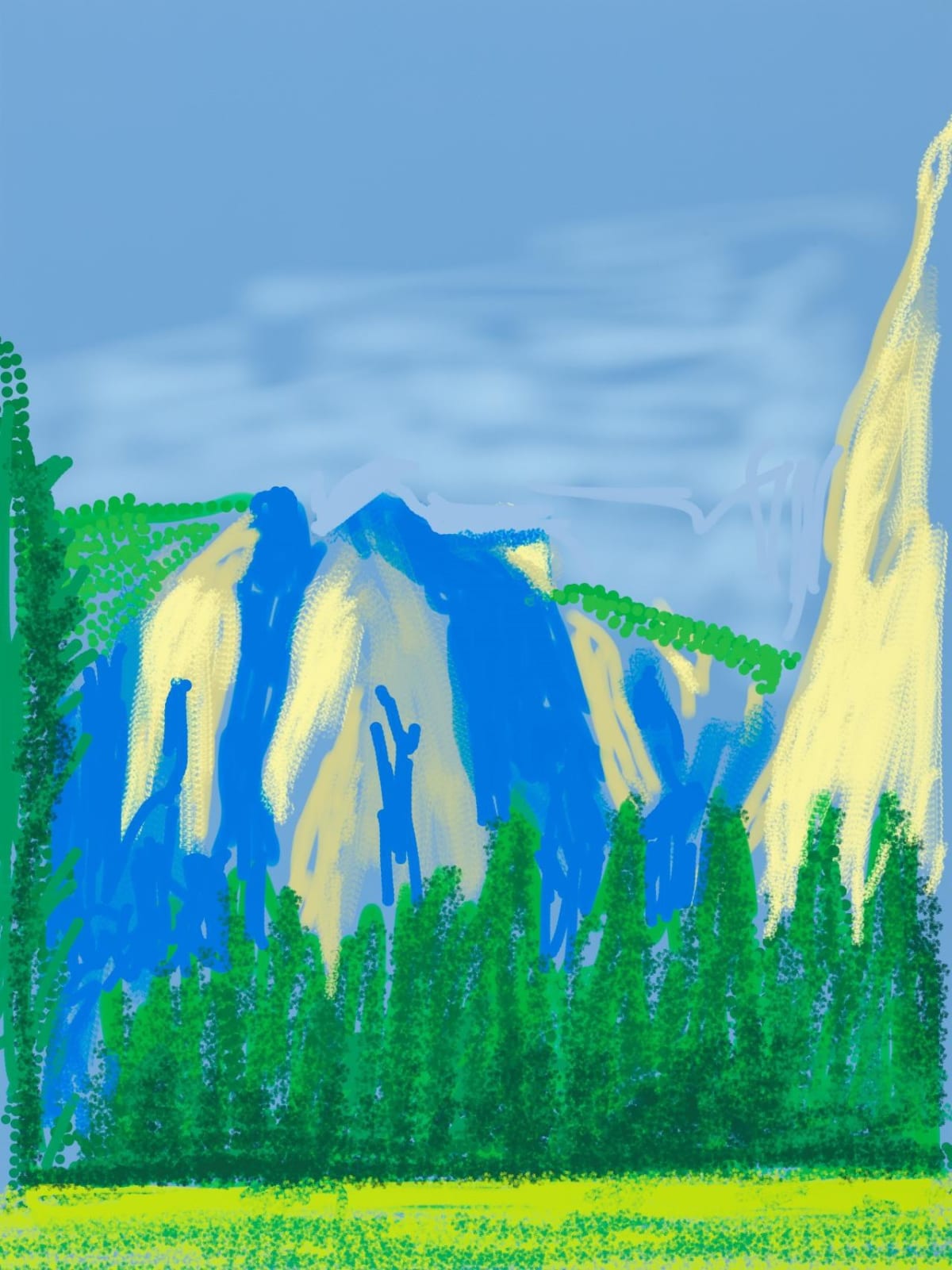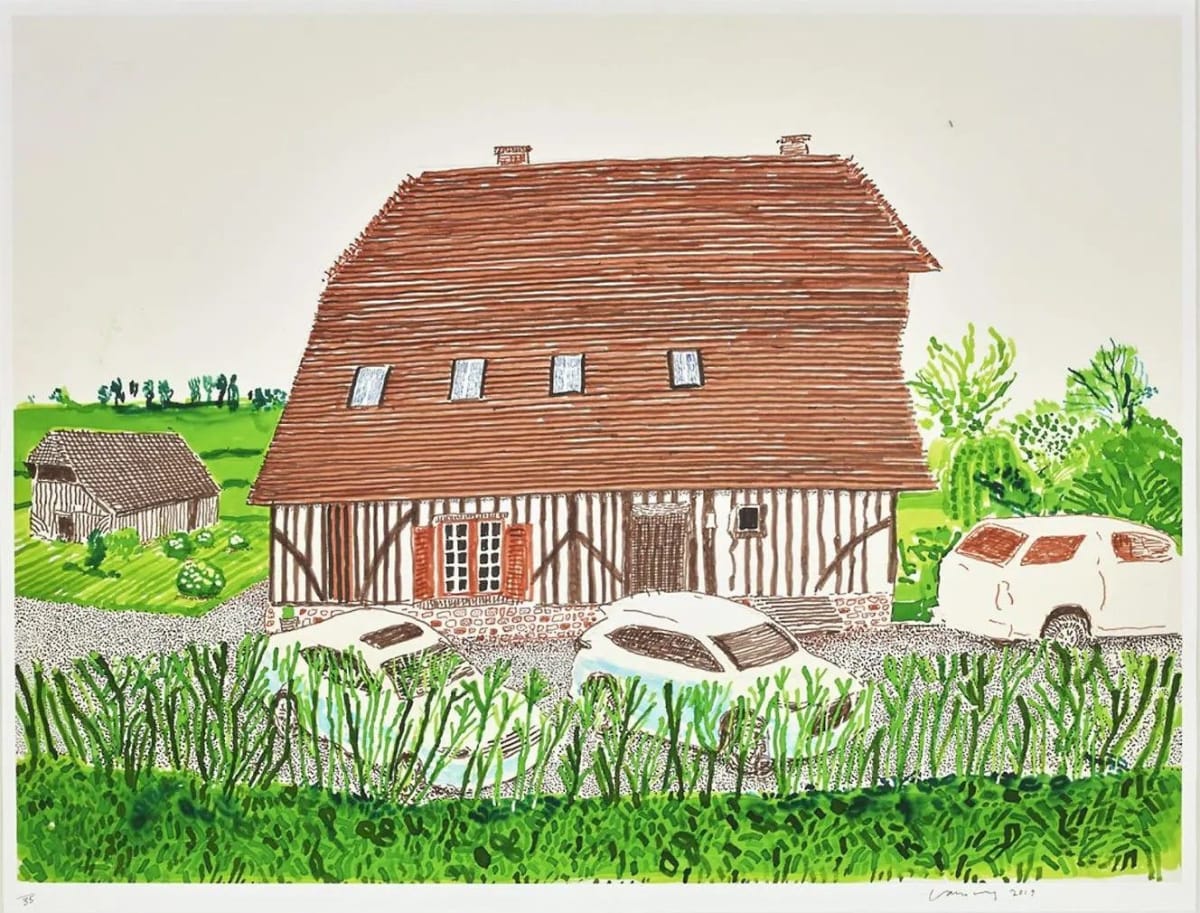
1937-1958: Bradford—The Cradle of Hockney's Artistic Beginnings
David Hockney was born and raised in Bradford, West Riding of Yorkshire, in the north of England. Bradford, with its industrial landscape juxtaposed against the surrounding moorlands, provided a unique backdrop for Hockney's early life. From a young age, he demonstrated a keen aptitude for art, nurtured by his father, Kenneth Hockney, a conscientious objector who instilled in him a spirit of independent thought and creativity.
The Yorkshire landscape, with its expansive moors and pastoral scenery, would become a recurring motif in Hockney's work across his life, offering a source of continual renewal and inspiration. Even after leaving Yorkshire, the green ruralism of his home county would call him back, as seen in his later works that capture the essence of the region's natural beauty. The 1853 Gallery at Salts Mill in Saltaire, close to Bradford, houses many of Hockney's pieces, serving as a tribute to the place where his artistic journey began.
1959-1963: London Calling
Hockney’s move to London to study at the Royal College of Art (RCA) marked a significant shift in his artistic development. London in the early 1960s was a hub of cultural innovation and liberal ideas, providing fertile ground for Hockney to explore and express his burgeoning identity as both an artist and a gay man. The city’s vibrant art scene, coupled with its mix of historical and modern influences, allowed Hockney to expand his creative horizons.
London’s influence on Hockney can be seen in his early works, which often reflect the city’s energy and its role as a melting pot of ideas. This period was also crucial for Hockney’s personal growth, as he came out as gay in 1962—a bold move at a time when homosexuality was still illegal in the UK. The city’s cultural dynamism and its atmosphere of liberation fueled Hockney’s confidence in exploring themes of identity and love, as evidenced by works like "We Two Boys Together Clinging" (1961). London became not just a place of education for Hockney, but a catalyst for his artistic and personal evolution.
1964: Los Angeles—A Lifelong Love Affair with Light and Space
In 1964, Hockney made a transformative move to Los Angeles, seeking to escape the grey skies of post-war Britain. The move to California marked the beginning of a deep and enduring relationship with the American West Coast, where the bright sunlight, clear skies, and vibrant colours profoundly influenced his artistic style.
Los Angeles, with its unique blend of natural beauty and urban sprawl, provided Hockney with a new palette of experiences and imagery. The city’s ubiquitous swimming pools, with their inviting azure hues, became a central theme in his work, symbolising the laid-back lifestyle and endless summer that LA epitomised. His fascination with the interplay of light and water is perhaps best exemplified in his iconic painting, "Portrait of an Artist (Pool with Two Figures)" (1972), which captures the clarity and depth of Californian light in a way that resonated with audiences worldwide.
The significance of Los Angeles in Hockney’s oeuvre cannot be overstated. The city’s influence is evident not just in his swimming pool series but also in his exploration of space and perspective. The vast, open landscapes of California, from the deserts to the coastlines, allowed Hockney to experiment with new techniques, such as his photo collages, which sought to capture the multiplicity of human perception. Los Angeles, with its unique light and expansive spaces, became a muse for Hockney, fueling some of his most celebrated works. Inspired by the beautiful light of the state, Hockney would embark on the Weather Series where his deft treatment of the personality and emotions of weather could only have been created in California.

National Parks: Yosemite and the Grand Canyon—The Sublime Inspiration of Nature
Hockney’s love affair with the American landscape extended beyond Los Angeles to the majestic terrains of national parks like Yosemite and the Grand Canyon. These vast, natural wonders provided Hockney with the perfect setting to explore his interest in perspective and the representation of space. Confronted with the grandiosity of these landscapes, Hockney’s work took on a new scale, both in terms of size and ambition.
In his painting "A Bigger Grand Canyon" (1998), Hockney used multiple canvases to create a panoramic view of the canyon, capturing its immense scale and the complexity of its geological formations. His photo collages, such as "Pearblossom Highway" (1986), also reflect this interest in multiple perspectives, as he sought to depict the experience of moving through these vast spaces rather than simply representing them from a single viewpoint.
The American landscape, with its sublime beauty and sense of endless possibility, became a crucial source of inspiration for Hockney. It allowed him to push the boundaries of traditional representation and explore new ways of seeing and depicting the world around him. Indeed, not only does landscape shape Hockney at this stage of his career but exploration. Testament to his ingratiation in Aericana, Hockney’s Moving Focus series emerged from his relocation to the sunny climes of California and impressed by the vibrant landscapes, he adopted new colours and form in the series.

Late 90s: A Return to Yorkshire—Reconnecting with Roots
After decades of living abroad, Hockney began to spend more time in Yorkshire in the late 1990s, particularly as his mother’s health declined. This return to his roots sparked a renewed interest in the landscapes of his childhood, leading to some of the most celebrated works of his later career.
Yorkshire’s rolling hills, winding roads, and changing seasons provided Hockney with a familiar yet ever-changing subject. His series "The Arrival of Spring" (2011), which captures the transformation of the Yorkshire landscape from winter to spring, showcases Hockney’s ability to find beauty and inspiration in the natural world. Using iPads to create these works, Hockney combined traditional subject matter with modern technology, demonstrating his continual evolution as an artist.
This period of reconnection with Yorkshire was not just about nostalgia; it was a deep engagement with the landscape that had shaped his early years, filtered through the lens of a lifetime of experience and artistic exploration.

2019-Present: Normandy—A New Chapter in France
In 2019, Hockney made another significant move, this time to the picturesque region of Normandy in France. Drawn by the beauty of the French countryside and perhaps a desire for a quieter life, Hockney found in Normandy a new source of inspiration. The region’s changing seasons and tranquil landscapes provided the backdrop for his latest works, including the expansive "A Year in Normandie" (2020).
Normandy’s influence on Hockney is evident in his continued exploration of themes of light, colour, and time. The region’s pastoral charm and historical richness, exemplified by the Bayeux Tapestry, have inspired Hockney to create works that blend the traditional with the contemporary. His large-scale frieze, displayed at the Musée de la Tapisserie de Bayeux, reflects not only his engagement with the local landscape but also his deepening interest in narrative and the passage of time.
Normandy represents a new chapter in Hockney’s life and work, one that is rooted in a long tradition of artists finding inspiration in the French countryside. As he continues to live and work in Normandy, this beautiful region promises to be a wellspring of creativity for Hockney in the years to come. Indeed, Hockney would take refuge in the calming property and studio that is reflected in his Normandy series. Comprising of 13 prints, the works are an intimate portrait of not just a house but one which has become a home.

Throughout his life, David Hockney has been profoundly influenced by the places he has lived and visited. From the industrial landscape of Bradford to the sun-soaked streets of Los Angeles, and from the grandeur of America’s national parks to the quiet beauty of Normandy, each place has left an indelible mark on his work. Hockney’s ability to draw inspiration from his surroundings and translate that into art that resonates on a global scale is a testament to his genius as an artist. As he continues to explore new places and ideas, the world eagerly awaits the next chapter in his extraordinary artistic journey.
Discover David Hockney prints for sale and contact Andipa Editions via sales@andipa.com or call +44 (0)20 7589 2371 for further information as to current availabilities.
